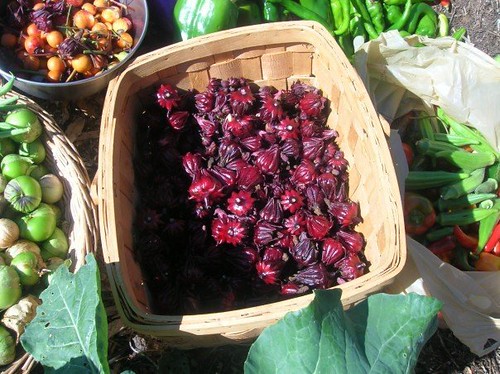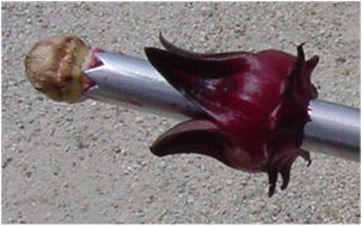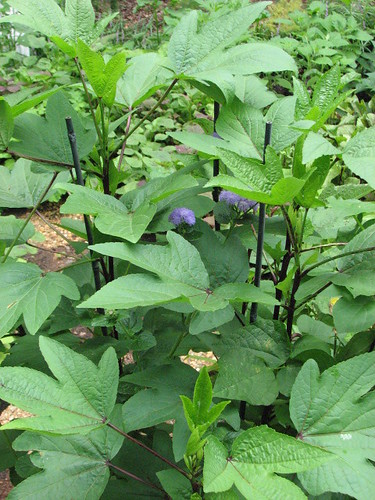How to Grow and Use Tea Hibiscus/Florida Cranberry
I get excited about foods I’ve never grown before and for a few years now I’ve tried my hand at growing Hibiscus sabdariffa, which you may be familiar with as the “zinger” in Celestial Seasonings Red Zinger tea.

Photo Caption: These are the calyces I harvested my first year growing H. sabdariffa. Tea hibiscus plants form fleshy calyces around their seed pods when the days become shorter in the fall.
H. sabdariffa is also known as tea hibiscus, red tea, Florida cranberry, roselle, and sorrel (unrelated to the leafy French sorrel).
It is, as the botanical name implies, a species of hibiscus. It is also in the same family as okra. Two varieties of H. sabdariffa are grown — one for fiber and the other for food.
I was interested in this plant mostly as a novelty to make tea and jelly from. This year I am planning to try it as a home-brewed beer flavoring. It can actually be eaten in many different ways — including raw in fruit salads. It is very tart, like a cranberry, with a crisp and succulent texture.
The entire calyx is used, minus the seed pod. Tools exist to remove the seeds for mass production but you can do it with a paring knife (or possibly a cherry/olive pitter):
Here some other uses (from this Purdue University article):
“Roselle fruits are best prepared for use by washing, then making an incision around the tough base of the calyx below the bracts to free and remove it with the seed capsule attached. The calyces are then ready for immediate use. They may be merely chopped and added to fruit salads. In Africa, they are frequently cooked as a side-dish eaten with pulverized peanuts. For stewing as sauce or filling for tarts or pies, they may be left intact, if tender, and cooked with sugar. The product will be almost indistinguishable from cranberry sauce in taste and appearance. For making a finer-textured sauce or juice, sirup, jam, marmalade, relish, chutney or jelly, the calyces may be first chopped in a wooden bowl or passed through a meat grinder. Or the calyces, after cooking, may be pressed through a sieve. Some cooks steam the roselle with a little water until soft before adding the sugar, then boil for 15 minutes.Roselle sauce or sirup may be added to puddings, cake frosting, gelatins and salad dressings, also poured over gingerbread, pancakes, waffles or ice cream. It is not necessary to add pectin to make a firm jelly. In fact, the calyces possess 3.19% pectin and, in Pakistan, roselle has been recommended as a source of pectin for the fruit-preserving industry.
Juice made by cooking a quantity of calyces with 1/4 water in ratio to amount of calyces, is used for cold drinks and may be frozen or bottled if not for immediate needs. In sterilized, sealed bottles or jars, it keeps well providing no sugar has been added. In the West Indies and tropical America, roselle is prized primarily for the cooling, lemonade-like beverage made from the calyces.”
You can direct-sow your plants but I prefer to start mine indoors about 5 weeks before the frost-free date. You can keep them indoors 8-10 weeks if you have bright greenhouse conditions. Be sure to harden off your plants before setting them out.
Rich soil and full sun will produce the largest, most fruitful plants but they are tolerant of poorer conditions and some dry weather. The most confusing thing about H. sabdariffa is that it does not begin to set flowers and fruit until the days become short. Therefore, your summer length is less relevant to production (although long summers grow larger plants that produce more fruit at the end of the season). Once the days begin to wane it does matter how much time your plants have before the first frost.
If your plants haven’t quite finished when freezing temps are imminent you can pull up your plants, roots and all, and store them in a bucket of water indoors to finish off the ripening process. Calyces are at harvest stage when they are between the size of a large marble to the size of a golf ball.
Use or preserve your harvest quickly, they will mold if left untended for long.
If you are interested in giving this unusual crop a try, here is where I buy my seeds:
“Roselle” from Nichol’s Garden Nursery
I have also bought and grown the named variety ‘Tea Time’ but variations of this plant have become increasingly difficult to find.
Good luck!
27 thoughts on “How to Grow and Use Tea Hibiscus/Florida Cranberry”
Comments are closed.



Pingback: How to Find Great Plants, Issue #3 | Appalachian Feet
p3chandan - February 2, 2011 7:35 am
I have just started to grow these plants in my garden, I love their flowers as they are pretty as ornamental plants and also for their fruits to make roselle juice which is rich in vitamin C.Thanks for the useful informations on the plant Eliza.
p3chandan´s last blog post ..Second chance of life
Rebecca - February 3, 2011 7:18 am
Interesting plant…. Thanks for including the site where you purchased the seeds. You’ll have to let us know how it works as a beer flavoring. Thanks for the info
Rebecca´s last blog post ..Wordless Wednesday
Pingback: How to Feel Inspired by an Urban Farm | Appalachian Feet
Karin - June 21, 2011 2:35 pm
I’m still a bit unclear…do I harvest the calyx before the flowers bloom, at their peak, or once they wilt back?
Sustainahillbilly
Twitter: appalachianfeet
- June 21, 2011 2:45 pm
You can harvest them before or after they bloom, but they’ll be larger and more plump after they’ve bloomed. The main thing is to harvest them while they are still tender. I pick mine when they are somewhere between the size of a large marble and a ping pong ball.
Chad - July 20, 2011 11:55 pm
Can you only use the calyx from some species? I have 3 different species of hibiscus at my home, but I don’t remember the calyx turning red…mabey I’m wrong. Can they be used if only green?
Sustainahillbilly
Twitter: appalachianfeet
- July 21, 2011 12:04 am
I’m only aware of Hibiscus sabdariffa having edible uses. If you’re talking about other, ornamental species of hibiscus, I can’t help — I haven’t heard of them being used in this manner.
Sustainahillbilly´s last blog post ..How to Identify Fusarium Wilt and Septoria Leaf Spot in Tomatoes
Sustainahillbilly
Twitter: appalachianfeet
- July 21, 2011 12:05 am
Also, all the H. sabdariffa that I’ve grown has never had a green stage for their calyxes. They start out red and remain that color throughout flowering and fruiting.
Ellen Leigh - September 12, 2011 6:33 pm
How’s the beer going. I am going to try flovoring my Kombucha. Yum. Thank you for the information.
Lynne - September 16, 2011 10:26 pm
What is the best way to dry them? I would be interested in using them for tea and jelly but if you have any other ideas for their use, be it fresh or dried, I’d love to try them. Thanks.
jan williams - September 18, 2011 8:19 pm
i purchased 2 in may and planted. they were very small. to my surprise they grew to 5 feet tall! a hurricane knocked them both over but didnt kill them. they are full of flowers and beautiful very large calyxes. I wish you could see them!
Pingback: Harvest petals of Roselle, Hibiscus sabdariffa for sunshine dry, making tea ….Thu hoạch cánh hoa Bụp Giấm để phơi nắng, làm trà …. | The Tea
Linda - September 6, 2012 12:00 pm
These hibiscus grow very easy and survive most of our winters here in Texas along the Gulf Coast. I have grown them for years but never knew they could be used for teas and such. The tea is a natural diuretic and it is believed that it can be used to control mild hypertension in some people. It has been working well for me.
julia - September 15, 2012 10:25 pm
I I live in North carolina I started seed in march in door I moved out in my yard in april. Around June I have some fruit: total about 20 of them. I have about 5 plants. Now it is September 15, Do you think I will get more fruits in the fall? They are very big bush now.
I wonder why they fruit 2 time a year???
Sustainahillbilly
Twitter: appalachianfeet
- January 16, 2013 10:12 am
I don’t know, mine have never fruited twice a year. Let us know!
jenny - September 21, 2012 3:54 pm
my roselle plant is now starting to flower. can I use the buds for tea raw or do i have to wait for them to dry. I picked some ping pong ball size but understand that you can use the ones before they
flower also. I don’t believe these would even have any seed pods to pull out (since they are small) so I would be using them whole if I am correct.
this is my first time growing this plant – thanks
Sustainahillbilly
Twitter: appalachianfeet
- January 16, 2013 10:09 am
I’ve used them both fresh and dried.
Sandra Clark - February 20, 2013 10:57 am
HELP!!!! My Tea Hibiscus (H.sabdariffa) is COVERED with nasty-looking
things (aphids?)that are leaving bad-looking spots on the leaves and
the whole plant just looks terrible!! I’ve been letting the Milkweed
plants go with THEIR yellow aphids per the info I’ve gotten online,
saying they will eventually die and/or go away.
The Tea Hibiscus was in the same little flower bed as the Milkweed
and we’re trying to avoid ANY chemicals because we’re having Monarchs
laying their eggs on the milkweed and then the caterpillars are eating
the leaves. The two kinds of aphids look entirely different on the
two plants so I don’t know if the hibiscus will “self-heal” or if I
need to treat it with something, and what to use, and when will it
be edible again……it looks so awful that I wouldn’t want to eat
any part of it until it regrows new leaves, flowers, etc!
Can you help me please????
Sandra
Sustainahillbilly
Twitter: appalachianfeet
- March 2, 2013 8:54 pm
Can you order some live ladybugs and release them on it?
kcflowers - June 1, 2013 2:15 pm
I live in Northern California – Sonoma County – where we have cool nights, foggy mornings, and very low humidity. I was given seed of H. sabdariffa, had great germination, now have plants ready to put in the garden. Do you think they will do well OK in my growing conditions?
Eliza Lord
Twitter: appalachianfeet
- June 3, 2013 1:18 pm
Does okra do well for you? It’s similar. I can’t say I have any experience with your growing conditions so I don’t know… maybe you can tell us after you try it!
Pingback: Seeds and pod of Hibiscus sabdariffa …Trái Bụp Giấm với hạt … | Food & Cooking
Pingback: Seeds and pod of Hibiscus sabdariffa …Trái Bụp Giấm với hạt … | Farmer Trees in the US
Pingback: Harvest petals of Roselle, Hibiscus sabdariffa for sun dry, making tea ….Thu ho?ch cánh hoa B?p Gi?m ?? ph?i n?ng, làm trà …. | Health,Wealth and Happiness
Sandy - September 11, 2014 3:03 pm
I was given a couple plants a couple years ago and love them for tea and their beautiful flowers. I got married last October and I love the plant so much I made my bouquets from the flower and the beautiful calyces, we also covered our archway with long stems of the plant still filled with flowers and calyces, with the pretty leaves, red coloring, and added small amount of baby’s breath it was gorgeous. I also made table decor with glass bowls filled with water, pebbles in bottom and floated 3-5 calyces in it. No one had ever even seen the plant or flower before so it wasw cool.
Pingback: News: Eliza on TV, Upcoming Events, and Our Favorite “How To” Articles | Appalachian Feet